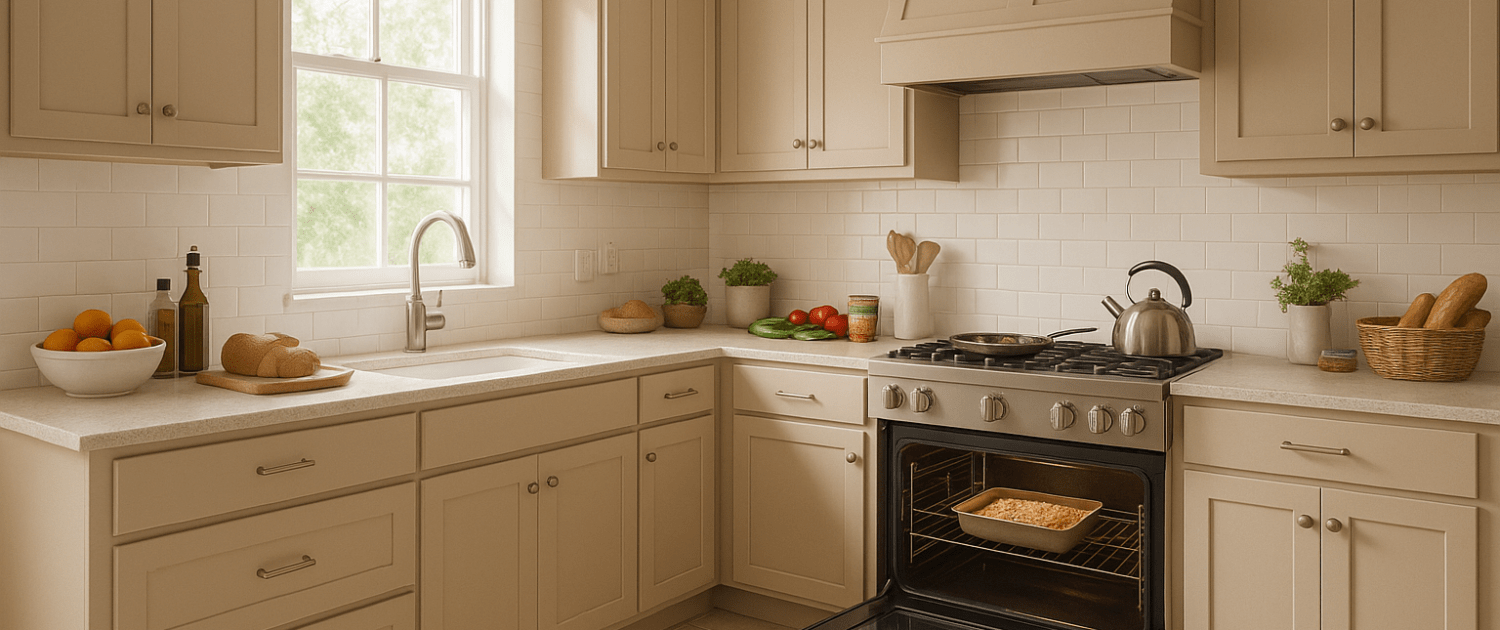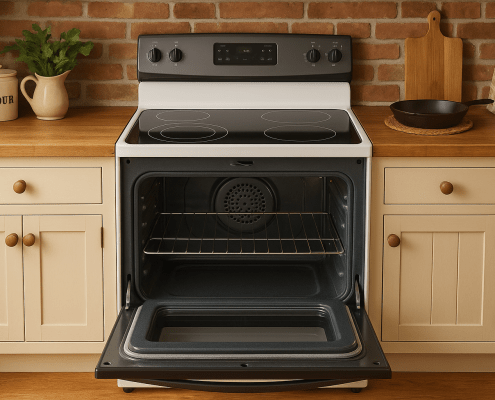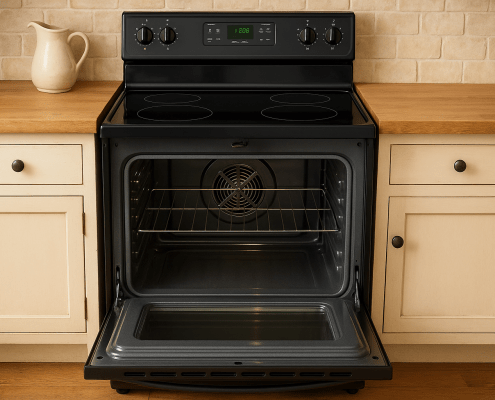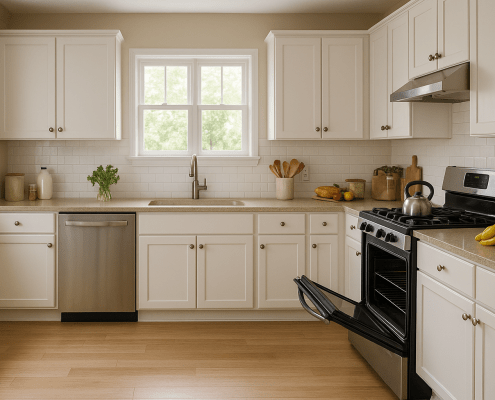Fix Your Gas Oven Combustion to Lower Carbon Monoxide Risks
Steven E / Tuesday July 15, 2025
Ever wondered if your gas oven is burning clean, or if it might be releasing too much carbon monoxide? Good news: it’s easier than you think to check. A quick test for proper combustion not only helps your stove run better but also keeps your indoor air safe. Here’s how to test your gas stove oven for proper combustion and lower CO levels like a pro.
Why Proper Combustion Matters
Any appliance that burns gas produces carbon monoxide, but it’s only dangerous when combustion is incomplete. A properly adjusted stove and oven will burn fuel almost completely, producing a steady blue flame, minimal CO, and maximum heat output. When something goes wrong , like clogged burners, poor airflow, or worn parts , the flame burns yellow or orange, combustion is inefficient, and more CO is produced.
Testing for proper combustion and adjusting your appliance as needed gives you:
- Cleaner indoor air with lower CO levels
- Safer operation of your appliance
- Even cooking and baking performance
- Lower energy bills from efficient fuel use
- Longer life for your stove and oven
Signs Your Stove or Oven May Have a Combustion Problem
Before you even start testing, your appliance may already be giving you clues. Here are some warning signs that your stove or oven isn’t burning fuel properly:
- Burner flames are mostly yellow or orange instead of blue
- Flames flicker or look uneven
- Soot or scorch marks on cookware or around burner ports
- Oven takes longer to reach set temperature
- Cooking results are uneven, with hot and cold spots
- You notice a stale, stuffy, or smoky smell in the kitchen
- CO detector near the kitchen sounds an alarm
If you’re noticing any of these, it’s time to test and tune up your appliance.
What Causes High CO Levels and Poor Combustion
There are a few common causes of improper combustion in gas stoves and ovens. Most are easy to fix once you know what to look for:
- Dirty or Clogged Burner Ports: Burners have small holes (ports) that mix gas and air to create a flame. When they’re clogged with grease, food debris, or dust, airflow is restricted and fuel burns incompletely.
- Misaligned or Damaged Burner Caps: If the cap isn’t seated properly on the burner base, flames can lift, flicker, or turn yellow.
- Dirty Orifices: The orifice is the tiny brass nozzle that meters gas into the burner. Dirt or damage can restrict gas flow, leading to uneven burning.
- Blocked Air Shutter: The air shutter controls how much air mixes with the gas before ignition. If it’s blocked or set incorrectly, the flame can be starved of oxygen.
- Worn Out Ignition Parts: Weak spark igniters or pilot assemblies can cause delayed ignition and uneven flames.
By identifying which part is causing the problem, you can clean, adjust, or replace it and restore proper combustion.
How to Test Your Gas Stove Burners
Testing your burners is the first step. It’s easy to do and only takes a few minutes.
- Check Flame Color: Turn each burner on high and observe the flame. A healthy flame is steady and blue, with only a very small yellow tip. If most of the flame is yellow, orange, or flickering, that’s a sign of incomplete combustion.
- Check Flame Shape and Height: A good flame is strong and evenly distributed around the burner. It should not be lifting, sputtering, or looking uneven. Compare each burner , they should all look consistent.
- Listen for Unusual Sounds: A proper flame burns quietly. If you hear roaring, hissing, or popping, it usually means too much or too little air.
How to Test Your Gas Oven
The oven burner can be a little harder to see, but it’s just as important to test.
Observe the Oven Burner Flame
With the oven set to bake and fully preheated, open the oven door and carefully look at the burner flame. It should be even and blue along its entire length. Uneven flames, yellow streaks, or flickering indicate poor combustion.
Watch for Hot Spots
Place a few slices of bread or a cookie sheet with parchment paper in the oven and bake briefly. Uneven browning suggests uneven heating and may be linked to burner problems.
Fixes for Poor Combustion
Once you’ve tested your stove and oven and identified issues, here’s how to fix the most common problems:
Clean Burner Ports
- Remove burner caps and scrub the ports with a stiff brush or toothpick.
- Make sure all ports are clear and unobstructed.
- Vacuum or wipe away loose debris before reassembling.
Reseat Burner Caps
- Make sure each cap is properly aligned and seated flat on the base.
- Adjust until flames are even and stable.
Clean or Replace Orifices
- Use a soft brush to clean the orifice opening.
- If it’s damaged, replace it with the correct size and type for your appliance model.
Adjust Air Shutters
- Many burners have an adjustable air shutter near the orifice. Open or close slightly to achieve a steady blue flame.
Replace Worn Ignition Parts
- If sparks are weak or the pilot is sputtering, replace igniters, thermocouples, or pilot assemblies as needed.
Where To Find Us
If you need any replacement parts for your appliances, you can enter your model number at AppliancePartsPros.com to locate and order them quickly. Most orders arrive in just two business days, and we have tons of great information in our repair help section and YouTube videos to help you troubleshoot.
Stay connected with the latest DIY tips, tutorial videos, and repair guides by following us on Facebook, Instagram, and Twitter. We love hearing about your repair stories and successes. If you need more help or want personalized guidance, feel free to reach out. We’re ready to help you take on your next project with confidence!
The information in this article may not apply to your specific appliance model. We recommend consulting your manufacturer’s documentation or contact us with any questions.
With nearly a decade of experience in providing top-notch customer service regarding appliance parts and repair, Steven enjoys sharing practical advice, troubleshooting tips, and interesting information to help readers stay informed.





